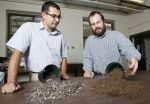(Press-News.org) VIDEO:
Boston College DeLuca Professor of Biology Marc A.T. Muskavitch discusses his latest malaria research, published in the journal Science. Muskavitch and an international team of researchers developed the first high-resolution...
Click here for more information.
CHESTNUT HILL, Mass. (10/25/2010) – The development and first use of a high-density SNP array for the malaria vector mosquito have established 400,000 genetic markers capable of revealing new insights into how the insect adapts to outsmart insecticides and other preventive measures, according to findings published in the current edition of the journal Science. The SNP array's snapshot of the Anopheles gambiae genome can be used by scientists worldwide to advance public health efforts to contain and eliminate the deadly disease, according to Boston College biologist and senior author Marc A.T. Muskavitch.
The SNP array, a technology used to examine hundreds of thousands of features within DNA, detects single nucleotide polymorphisms and establishes genetic markers that can be used to understand the entire genome, particularly with respect to disease susceptibility and the likely success of insecticides and other mosquito-targeted interventions.
"We have developed a set of 400,000 markers with which we can study the genetics of the malaria vector mosquito Anopheles gambiae," said Muskavitch, the DeLuca Professor of Biology at Boston College, who co-authored the paper with an international team of researchers. "Each marker is like a genetic signpost along the genome. These markers have revealed that when mosquito populations begin to separate from each other, it is a very complicated process that can involve hundreds of genes. The genes we have identified are genes that we can now investigate, to better understand their roles in the complexity of mosquito populations."
The malaria mosquito is a member of a complex of seven species of mosquitoes, and within that complex are multiple populations that can display different traits and behaviors. Over many decades, modern public health efforts have sought to stop these mosquitoes, which spread the malaria parasite by taking blood meals from humans. Insecticides have been found to lose their effectiveness when the insects develop resistance to them. Muskavitch says the SNP array will yield powerful new scientific insights into these changes, which can support public health efforts in sub-Saharan Africa, where the disease is most prevalent, and elsewhere throughout the world.
"Our best tools for stopping vector mosquitoes that transmit malaria depend on mosquitoes that bite us at night when we are asleep and then rest inside our dwellings after they take our blood," Muskavitch said. "But we have already seen that mosquitoes are changing. They are beginning to bite during the day, or to rest outside. By using the SNP array, we can begin to understand the genes that lead to these differences in behavior."
He added, "Over the past 10 years, efforts on an international scale to improve the control of malaria and eliminate it have intensified. Health efforts on the ground involve the distribution of interventions. But because mosquitoes can outsmart insecticide-based interventions, we need to inform the use of those interventions with scientific insights into the genomics of vector mosquitoes."
The team - which included researchers from Boston College, the Broad Institute, Imperial College London, the University of Notre Dame, Harvard University and the Malaria Research and Training Center in Mali - designed the Anopheles gambiae (AG) SNP1 Array in collaboration with Santa Clara, California-based Affymetrix. The array features 400,000 SNPs from among the 3 million found in four sequenced strains of Anopheles gambiae, which provides an immensely higher resolution than the 42- and 1,536-marker sets previously available to malaria vector biologists.
Muskavitch said the development of the array is an essential advance for researchers working toward the goal of eradicating malaria, which has been set forth by the Bill and Melinda Gates Foundation, a leading funder of malaria research.
"By obtaining insights into the genetic changes that underlie the adaptations of mosquitoes to evade our interventions, we have a better chance of making sure that mosquitoes can be controlled," Muskavitch said. "The development of this array depended critically on working with African colleagues who understand the transmission of malaria and work to control it in their home countries. Now that we have established this approach for Anopheles gambiae, we are beginning to work with even more scientists in Africa who are working to understand and control the mosquitoes that transmit this deadly disease."
INFORMATION: END
Thanks to a microwave oven, the fundamental nanotechnology process of self assembly may soon replace the lithographic processing use to make the ubiquitous semi-conductor chips. By using microwaves, researchers at Canada's National Institute for Nanotechnology (NINT) and the University of Alberta have dramatically decreased the cooking time for a specific molecular self-assembly process used to assemble block copolymers, and have now made it a viable alternative to the conventional lithography process for use in patterning semi-conductors. When the team of chemists and ...
Turning up the heat might be the best thing for athletes competing in cool weather, according to a new study by human physiology researchers at the University of Oregon.
Published in the October issue of the Journal of Applied Physiology, the paper examined the impact of heat acclimation to improve athletic performance in hot and cool environments.
Researchers conducted exercise tests on 12 highly trained cyclists -- 10 males and two females -- before and after a 10-day heat acclimation program. Participants underwent physiological and performance tests under both ...
HOUSTON, Oct. 25, 2010 – Some unexpected effects of lead exposure that may one day help prevent and reverse blindness have been uncovered by a University of Houston (UH) professor and his team.
Donald A. Fox, a professor of vision sciences in UH's College of Optometry (UHCO), described his team's findings in a paper titled "Low-Level Gestational Lead Exposure Increases Retinal Progenitor Cell Proliferation and Rod Photoreceptor and Bipolar Cell Neurogenesis in Mice," published recently online in Environmental Health Perspectives and soon to be published in the print ...
WEST LAFAYETTE, Ind. - Greenhouse plant growers can substitute rice hulls for perlite in their media without the need for an increase in growth regulators, according to a Purdue University study.
Growing media for ornamental plants often consists of a soilless mix of peat and perlite, a processed mineral used to increase drainage. Growers also regularly use plant-growth regulators to ensure consistent and desired plant characteristics such as height to meet market demands. Organic substitutes for perlite like tree bark have proven difficult because they absorb the plant-growth ...
As the ice-capped Arctic Ocean warms, ship traffic will increase at the top of the world. And if the sea ice continues to decline, a new route connecting international trading partners may emerge -- but not without significant repercussions to climate, according to a U.S. and Canadian research team that includes a University of Delaware scientist.
Growing Arctic ship traffic will bring with it air pollution that has the potential to accelerate climate change in the world's northern reaches. And it's more than a greenhouse gas problem -- engine exhaust particles could ...
GAINESVILLE, Fla. — New University of Florida research puts to rest the mystery of where old carbon was stored during the last glacial period. It turns out it ended up in the icy waters of the Southern Ocean near Antarctica.
The findings have implications for modern-day global warming, said Ellen Martin, a UF geological sciences professor and an author of the paper, which is published in this week's journal Nature Geoscience.
"It helps us understand how the carbon cycle works, which is important for understanding future global warming scenarios," she said. "Ultimately, ...
WEST LAFAYETTE, Ind. - Researchers found a previously unmapped fault was responsible for the devastating Jan. 12 earthquake in Haiti and that the originally blamed fault remains ready to produce a large earthquake.
Eric Calais, a Purdue University professor of earth and atmospheric sciences, led the team that was the first on the ground in Haiti after the magnitude 7.0 earthquake, which killed more than 200,000 people and left 1.5 million homeless.
The team determined the earthquake's origin is a previously unmapped fault, which they named the LÄogëne fault. The newly ...
CHICAGO, Oct. 25, 2010 – Young children who consume substantial amounts of fluoride through infant formula and other beverages mixed with fluoridated water or by swallowing fluoride toothpaste have an increased chance of developing mild enamel fluorosis, according to research published in the October issue of The Journal of the American Dental Association and supported by the National Institute of Dental and Craniofacial Research. Children can continue using fluoridated water and fluoride toothpaste because fluoride has been proven to prevent tooth decay, and mild fluorosis ...
While most commonly associated with mononucleosis, Epstein-Barr virus (EBV) has been linked to many diseases that affect people long after the initial infection takes place, including some forms of cancer. In the current issue of the Journal of Biological Chemistry, scientists at The Wistar Institute describe how viral microRNA – small segments of RNA that suppress the effects of gene activity – allows EBV to hide within cells and evade the immune system. The scientists believe their findings may one day enable physicians to flush EBV out of hiding, allowing a healthy immune ...
CAMBRIDGE, Mass. -- Researchers at MIT have revealed exactly how a molecule called fulvalene diruthenium, which was discovered in 1996, works to store and release heat on demand. This understanding, reported in a paper published on Oct. 20 in the journal Angewandte Chemie, should make it possible to find similar chemicals based on more abundant, less expensive materials than ruthenium, and this could form the basis of a rechargeable battery to store heat rather than electricity.
The molecule undergoes a structural transformation when it absorbs sunlight, putting it into ...



